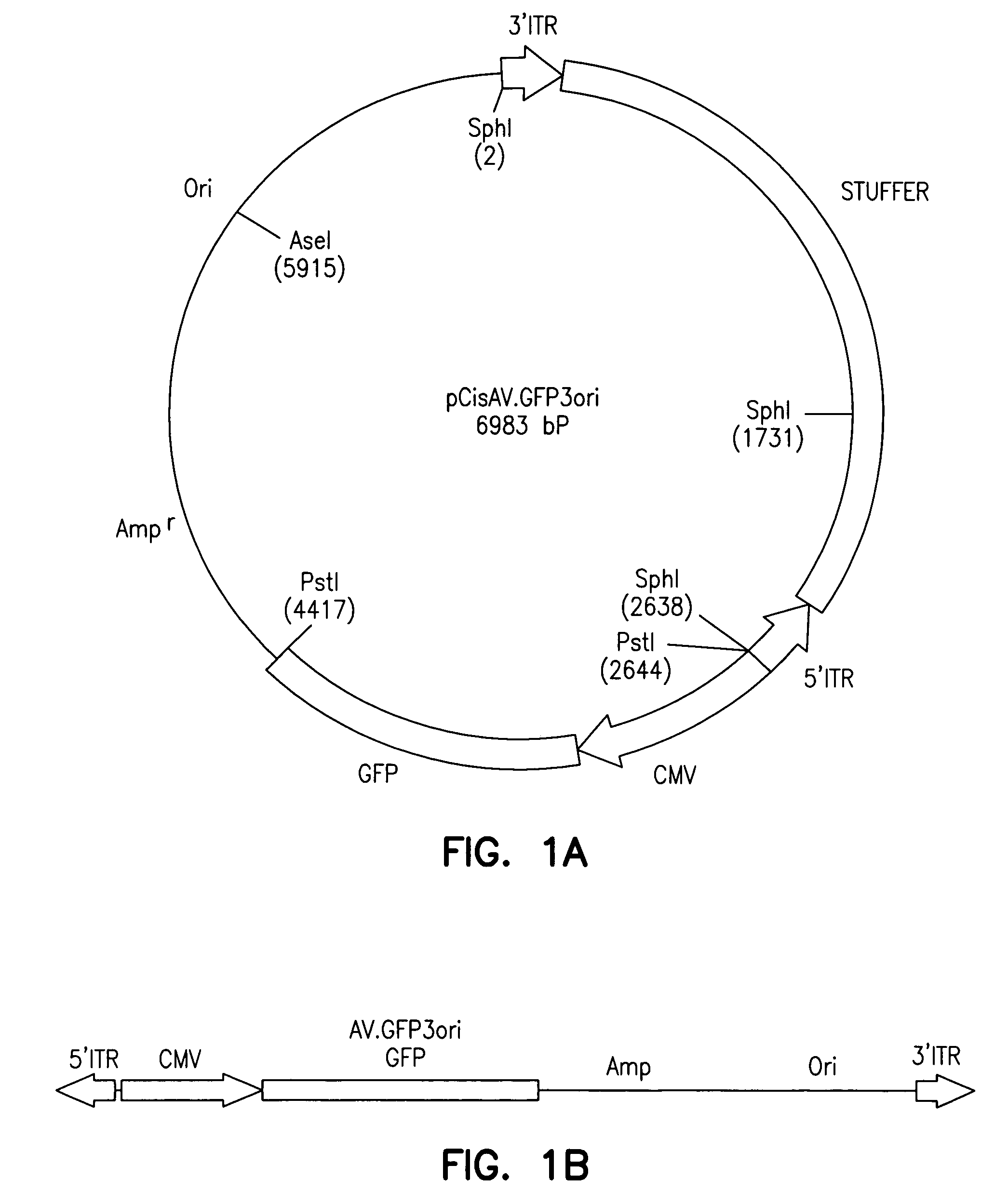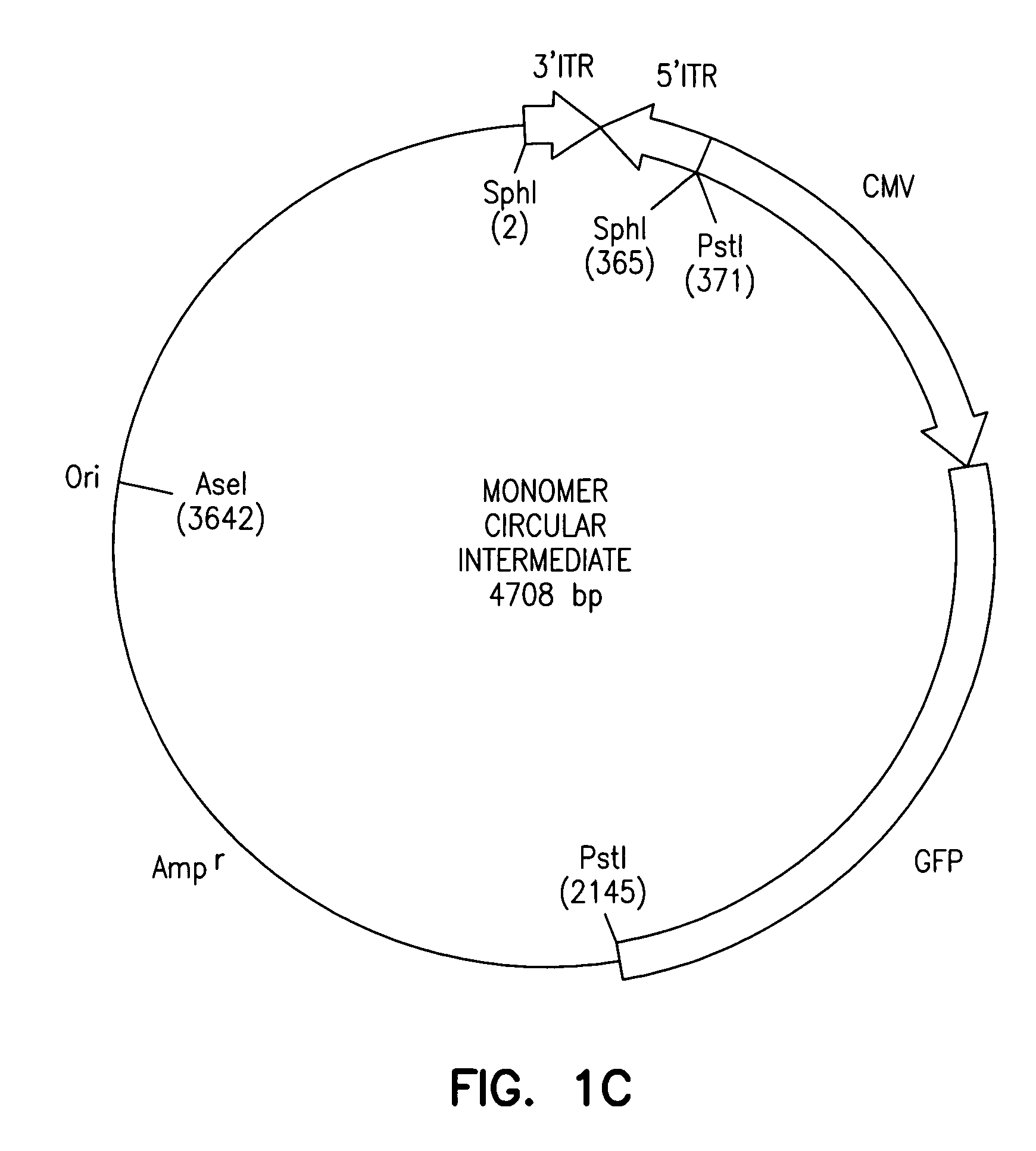[0012]The present invention provides a recombinant adeno-associated virus (rAAV) vector comprising a
nucleic acid segment formed by the juxtaposition of sequences in the AAV inverted
terminal repeats (ITRs) which are present in a circular intermediate of AAV. The circular intermediate was isolated from rAAV-infected cells by employing a recombinant AAV “shuttle” vector. The
shuttle vector comprises: a) a bacterial
origin of replication; b) a
marker gene or a selectable
gene; c) a 5′ ITR; and d) a 3′ ITR. Preferably, the recombinant AAV
shuttle vector contains a
reporter gene, e.g., a GFP,
alkaline phosphatase or β-galactosidase
gene, a
selectable marker gene, e.g., an
ampicillin-resistance gene, a bacterial
origin of replication, a 5′ ITR and a 3′ ITR. The vector is contacted with eukaryotic cells so as to yield transformed eukaryotic cells. Low molecular weight DNA (“Hirt DNA”) from the transformed eukaryotic cells is isolated. Bacterial cells are contacted with the Hirt DNA so as to yield transformed bacterial cells. Then bacterial cells are identified which express the marker or selectable gene present in the
shuttle vector and which comprise at least a portion of a circular intermediate of adeno-associated virus. Also, as described below, it was found that circularized intermediates of rAAV impart episomal persistence to linked sequences in
Hela cells, fibroblasts and
muscle cells. In
HeLa cells, the incorporation of certain AAV sequences, e.g., ITRs, from circular intermediates into a
heterologous plasmid conferred a 10-fold increase in the stability of
plasmid-based vectors in
HeLa cells. Unique features of these transduction intermediates included the
in vivo circularization of a head-to-
tail monomer as well as multimer (concatamers) episomal
viral genomes with associated specific
base pair alterations in the 5′ viral D-sequence. The majority of circular intermediates had a consistent head-to-
tail configuration consisting of
monomer genomes (<3 kb) which slowly converted to large multimers of >12 kb by 80 days post-infection in
muscle. Importantly, long-term
transgene expression was associated with prolonged (80 day) episomal persistence of these circular intermediates. Thus,
in vivo persistence of rAAV can occur through episomal circularized genomes which may represent prointegration intermediates with increased episomal stability. Moreover, as described below, co-infection with adenovirus, at high multiplicities of infection (MOI) capable of producing early adenoviral gene products, led to increases in the abundance and stability of AAV circular intermediates which correlated with an elevation in
transgene expression from rAAV vectors. Thus, these results demonstrate the existence of a molecular structure involved in AAV transduction which may play a role in episomal persistence and / or integration.
[0013]Further, these results may aid in the development of non-viral or viral-based
gene delivery systems having increased efficiency. For example, therapeutic or prophylactic therapies in which the present vectors are useful include blood disorders (e.g.,
sickle cell anemia, thalassemias,
hemophilias, and Fanconi anemias), neurological disorders, such as Alzheimer's
disease and Parkinson's
disease, and
muscle disorders involving skeletal, cardiac or
smooth muscle. In particular, therapeutic genes useful in the vectors of the invention include the β-
globin gene, the γ-
globin gene, the
cystic fibrosis transmembrane conductance
receptor gene (CFTR), the
erythropoietin (epo) gene, the Fanconi
anemia complementation group, a gene encoding a
ribozyme, an antisense gene, a
low density lipoprotein (LDL) gene, a
tyrosine hydroxylase gene (Parkinson's
disease), a
glucocerebrosidase gene (Gaucher's disease), an arylsulfatase A gene (metachromatic leukodystrophies) or genes encoding other polypeptides or proteins. Also within the scope of the invention is the inclusion of more than one gene in a vector of the invention, i.e., a plurality of genes may be present in an individual vector. Further, as a circular intermediate may be a concatamer, each
monomer of that concatamer may comprise a different gene, or a portion thereof.
[0017]Therefore, the present invention provides an isolated and purified DNA molecule comprising at least one DNA segment, a biologically active
subunit or variant thereof, of a circular intermediate of adeno-associated virus, which DNA segment confers increased episomal stability, persistence or abundance of the isolated DNA molecule in a host
cell. Preferably, the DNA molecule comprises at least a portion of a left (5′)
inverted terminal repeat (ITR) of adeno-associated virus. Also preferably, the DNA molecule comprises at least a portion of a right (3′)-
inverted terminal repeat of adeno-associated virus. The invention also provides a
gene transfer vector, comprising: at least one first DNA segment, a biologically active
subunit or variant thereof, of a circular intermediate of adeno-associated virus, which DNA segment confers increased episomal stability or persistence of the vector in a host
cell; and a second DNA segment comprising a gene. Preferably, the second DNA segment encodes a therapeutically effective polypeptide. The first DNA segment comprises ITR sequences, preferably at least about 100, more preferably at least about 300, and even more preferably at least about 400, bp of adeno-associated virus sequence. A preferred vector of the invention is a
plasmid.
[0024]Also provided is a method in which the composition of the invention is administered to the cells or tissues of an animal. For example, rAAV vectors have shown promise in transferring the
CFTR gene into
airway epithelial cells of animal models and nasal sinus of CF patients. However,
high level expression of CFTR has not been achieved due to the fact that AAV cannot accommodate the full-length
CFTR gene together with a potent
promoter. A number of studies have tried to optimize rAAV-mediated CFTR expression by utilizing truncated or partially deleted CFTR genes together with stronger promoters. However, it is currently unknown what effect deletions within the
CFTR gene may have on
complementation of
bacterial colonization defects in the CF
airway. Therefore, the present invention includes the administration to an animal of a composition of the invention comprising at least two rAAV vectors which together
encode CFTR. The present invention is useful to overcome the current size limitation for transgenes within rAAV vectors, and allows for the incorporation of a larger transcriptional
regulatory region, e.g., a stronger
heterologous promoter or the endogenous CFTR
promoter.
[0025]As described hereinbelow, transgene expression from rAAV
luciferase vectors, with or without a promoter, can be greatly enhanced by co-infection with an independent rAAV vector carrying the cytomegalovirus (CMV) and simian virus 40 (SV40) enhancers. Thus, co-infection with a transgene containing vector and a second vector comprising at least one, preferably at least two or more,
enhancer sequences, of cell lines and muscle in vivo resulted in a greater than 600-fold enhancement of transgene expression from a minimal SV40 promoter. Furthermore, 200-fold enhancement was also achieved by cis-activation of ITRs in transgene containing vectors without a promoter. Thus, large regulatory elements including
tissue specific enhancers can be introduced into cells by a separate rAAV to regulate the expression of a second transgene containing vector in cis following
intracellular concatamerization.
[0031]In yet another embodiment of the invention, the second DNA segment of the first
recombinant DNA molecule comprises a cis-acting integration sequence(s) for a
recombinase and also encodes a
recombinase or
integrase that is specific for the integration sequence(s), e.g., Cre / lox
system of
bacteriophage P1 (U.S. Pat. No. 5,658,772), the FLP / FRT
system of
yeast, the Gin
recombinase of phage Mu, the Pin recombinase of E. coli, the R / RS
system of the pSR1 plasmid, a retrotransposase or the
integrase from a
lentivirus or
retrovirus. The second DNA segment in the second
recombinant DNA molecule comprises at least a portion of an
open reading frame, and preferably a promoter operably linked to the
open reading frame. The formation of a concatamer comprising the first and the second
recombinant DNA molecules, and the expression of the recombinase or
integrase, will enhance the integration of the concatamer, or a portion thereof, into the
host genome.
 Login to View More
Login to View More 


